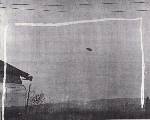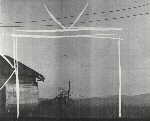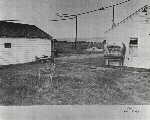Case 46
McMinnville, Oregon
11 May 1950
Investigator: Hartmann
Abstract:
Witness I reportedly saw a metallic-looking, disk-shaped UPO. She
called her husband, they located their camera, and he took
photographs of the object before it disappeared in the distance.
Background:
Time: 7:45 p.m. PST (1,2); 7:30 p.m. (3).
Position: Approx. 10 mi. SW of McMinnville, Ore. on the farm of the
witnesses: 123 19' 50" W, 45 06' 15" N (7).
Terrain: Rolling farm country, elv. 210 ft.; houses several hundred
meters apart (7).
Weather Conditions: Dull with an overcast at about 5,000 ft. (2,
confirmed by the photos).
Sighting, General Information:
The sighting occurred in the back yard of a farm about 0.2 mi. S of
the "Salmon River Highway" (U.S. 99W (7). Witness was feeding rabbits
in the back yard, S of the house and E of the garage when the object
was first sighted (1,2,3,6), apparently toward the NE (6). Witness II
was apparently in the house at this moment, as three of the accounts
(2,3,6) refer to Witness I calling to him and running into the house
to fetch him from the kitchen, although one account (1) states that
they had "been out in the back yard," and "both... saw it at the same
time."
As far as Witness I could remember 17 yr. later (6), the rabbits gave
no indication of disturbance.
[[607]]
[[608]]
a good-sized parachute canopy without the strings, only silvery-
bright mixed with bronze'" (2); silvery on top but with more bronze
on the bottom, the bottom being different (but, this being seventeen
years later, Witness I was unsure whether it was darker)...shiny but
not as bright as a hub cap...resembling a dull, aluminum-painted tank
(which Witness I pointed out to the writer in our interview)...
"awful pretty" (6). The rather bright, aluminum-like, but not
specular, reflecting surface appears, to be confirmed by analysis of
the photos (see below). There was no noise, visible exhaust, flames,
or smoke (1,3,6).
When the object tipped up, exposing its under side to the witnesses,
they felt a gust of wind which they thought may have come from the
UFO. "'...there was a breeze as it went overhead... which died down
later'" (2). In the interview with the writer, Witness I stressed
this, remarking the wind was "about to knock you over," though
Witness II (interviewed separately) remarked that it made only a
"very little" breeze as it was getting ready to fly off (6).
As to size, speed, and distance, the witnesses were reluctant to
hazard a guess (1,2), as Witness II had no way of knowing its size
(2), although one of the references quotes Witness II as estimating a
diameter of "20 or 30 ft." (3), and Witness I compared its appearance
(though not explicitly its size) to a parachute canopy (2,6).
As to the origin of the UFO, Witness II remarked both at the time and
in 1967 that he thought it was a secret U.S. craft (1). "'...you hear
so much about those things...1 didn't believe all that talk about
flying saucers before, but now I have an idea the Army knows what
they are'" (3).
Witness II recalls finishing his roll of film on Mother's Day (4) and
had it developed locally (1). Witness II mentioned his observation
and showed the pictures to a few friends. He did not seek publicity
about the pictures, admitting that he was "'kind of
scared of it'" (2,3), and "afraid they would get in trouble with the
'government' and be bothered by the publicity" (2). However,
McMinnville
Telephone Register reporter Bill Powell learned of
the sighting from two McMinnville bankers, Ralph and Frank Wortman,
and followed up the story (1,2). He found the negatives "on the floor
under a davenport where the Witnesses' children had been playing with
them" (2). The
Telephone Register broke the story Thursday, 8
June 1950 with a front page article containing the two pictures and
Editor's Note:
"...in view of the variety of opinion and reports attendant to the
saucers over the past two years, every effort has been made to check
Trent's photos for authenticity. Expert photographers declared there
has been no tampering with the negatives. [The] original photos were
developed by a local firm. After careful consideration, there appears
to be no possibility of hoax or hallucination connected with the
pictures. Therefore the Telephone Register believes them
authentic..." (1).
Various McMinnville residents, including the bankers Wortman, offered
to sign affidavits vouching unreservedly for the reputation and
veracity of the witnesses (1,2,4).
On Friday and Saturday, 9 and 10 June, the Portland, Ore., and Los
Angeles newspapers carried the story (2, 3). Life magazine carried
the pictures the following week (4). The witnesses accepted an
invitation to appear on a television program "We the People," in New
York (6). Witness I remarked that they were encouraged by the people
responsible for this show to make statements they (the Witnesses)
regarded as inaccurate. The witnesses, however, did not make such
statements, but told only what they saw (6).
While in New York, the witnesses were to receive their negatives from
Life magazine, but were informed that the negatives were
temporarily misplaced (6). Life promised to return them by mail
to
Oregon, but apparently never recovered them (6). With the cooperation
of
Life the Colorado project discovered that in 1950 the
negatives had been in the possession of International News Photo
Service later merged with United Press International. The Project
located the original negatives and was permitted to examine them. (8)
As mentioned above, various reputable individuals volunteered to
attest to the witnesses' veracity. They appear to be sincere, though
not highly educated or experienced observers. During the writer's
interview with them, they were friendly and quite unconcerned about
the sighting. Witness II was at work plowing his field and did not
even get off his tractor. From interviews throughout this district
one gained the impression that these were very industrious farm
people, not given to unusual pranks.
Two inferences appear to be justified: 1) It is difficult to see any
prior motivation for a fabrication of such a story, although after
the fact, the witnesses did profit to the extent of a trip to New
York; 2) it is unexpected that in this distinctly rural atmosphere,
in 1950, one would encounter a fabrication involving sophisticated
trick photography (e.g. a carefully retouched print). The witnesses
also appear unaffected now by the incident, receiving only occasional
inquiries (6).
The over-all appearance of the photographs, in particular the
slightly underexposed land foreground and properly exposed sky, is
consistent with the reported time 7:30 PST (sunset being roughly a
few minutes after 7:15, and twilight lasting until after 8:45). There
could be a possible discrepancy in view of the fact that the UFO, the
telephone pole, possibly the garage at the left, and especially the
distant house gables (left of the distant barn) are illuminated from
the right, or east. The house, in particular, appears to have a
shadow under its roof that would suggest a daylit photo, and combined
with the eastward incidence, one could argue that the photos were
taken on a dull, sunlit day at, say, 10 a.m.
[[611]]
But accepting the UFO makes scarcely less sense than arguing that the
witnesses staged a hoax at 10 a.m. and then claimed the photographs
were taken at 7:30. Densitometry of the original negatives shows that
the sky itself is brighter toward the west, as expected. It seems
posslble that, half an hour after sunset, the cloud distribution
could result in a dull illumination preferentially from the NE
(certainly there will be skylight from above).
Reality of physical object. As stated previously, it is unlikely
that a sophisticated "optical fabrication" was performed. The
negatives had not been tampered with.
Further, a geometric test was performed to determine whether the
object shown in Plate 24 in approximate cross section was the same
object photographed in Plate 23 at a different angle. The apparent
inclination, i, can be determined from the ratio of the axes of the
apparent ellipse in Plate 23.
i = b/a
(2)
Measures on several copies of photo 1 (the UPI print, an enlargement
thereof, and two magazine reproductions) gave sin i = 0.368, and
i = 21°.6 ± 0°.1 (est. P.E.).
(3)
Plate 26 shows enlargements from UPI print with lines of sight
superimposed on the Plate 24 "cross section" at 21°.6. The
way in which these lines cut the image is in perfect agreement with
the appearance of the object in Plate 23. Judging from the apparent
position of the pole it is likely that the object has simply tipped,
without rotation, between the two photos.
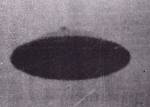
Plate 26a: McMinnville Enlargement 1
Click on Thumbnail to see Full-size image.

Plate 26b: McMinnville Enlargement 2
Click on Thumbnail to see Full-size image.
The lighting is also consistent with that in the rest of the photo.
Both photographs, therefore, show real objects and that the object in
Plate 23 is a view of the same object in Plate 24, seen in different
perspective.
Asymmetry of UFO. It will be noted in Plate 26 that the UFO is
distinctly asymmetric. The "pole" is off center and inclined, and
there appears to be a difference in the profiles of the right and
left sides (Plate 24), the left having a more pronounced notch
defining the flange. The shading of the object also indicates a
[[612]]
more distinct flange on the left in Plate 24. The asymmetries are
judged physical, not optical effects.
Absence of rotation. The top of the "pole," barely visible in
photo 1, is off center to the left by the same amount as in photo 2.
This would be rather improbable if the object were rotating, and
supports Witness II's statement that it was not rotating. This is a
rather strong argument against a fabrication using a necessarily (for
stability) spinning model similar to a "frisbee," especially in view
of the fact that only 2 exposures were made in the middle of an
intact roll of film.
Angular size of object. From measurements of recent photos (6)
the photos were scaled and the UFO diameters estimated to be:
| Plate 23: |
1°.4 |
| Plate 24: |
1°.3. |
The P.E. is probably about 0°.1, but the object subtends a
smaller angle in photo 2, consistent with the allegation that photo 2
was made as the UFO was beginning to depart.
It follows immediately that the distance-diameter relation is
determined, and a man of the locale (based on ref. 7) is shown in
Fig. 1 with the azimuths, angular sizes, and example, that the object
was less than a meter in diameter and over the driveway.
Psychological reaction. I judge it reasonable that as the object
allegedly drifted to the left, in danger of being lost to sight
behind the garage, that the observer should step unconsciously to his
right, as the photos show he did, although one might expect the
observer even more reasonably to step forward, to get in front of the
garage. The reason for the first response may have been that the
second would put the observer close to the house, where the object
might be lost to sight if it moved back to the east, while by moving
away from the garage, one moves toward the open Yard SE of the house.
In summary, the movement of the observer is consistent with the
alleged observation.
Possibility of fabrication. The above tests all appear to be
consistent with the witnesses' testimony. The possibility of optical
fabrication seems remote. A model thrown into the air by hand appears
an unlikely possibility because of the evidence for absence of
rotation.
Another possibility can be considered, however. The object appears
beneath a pair of wires, as is seen in Plates 23 and 24. We may
question, therefore, whether it could have been a model suspended
from one of the wires. This possibility is strengthened by the
observation that the object appears beneath roughly the same point in
the two photos, in spite of their having been taken from two
positions. This can be determined from irregularities, or "kinks," in
the wires. The wires pass between the camera positions and the garage
(left). We know from the change in orientation of the object that it
moved, or was re-oriented by hand, between exposures. The possibility
that it is a model hanging beneath a point on the wire suggests a
further test: Is the change in distance of the object in Plates 23
and 24 equal to the change in distance from the wires? Measures of
the disk indicate that it is about 8% further away in Plate 24.
Measures of the irregularities in the wires indicate that they are
further away from the camera in Plate 24. The amount of the latter
increase from the wires (measured by the separation of rather
ill-defined "kinks") is less certain than the distance increase from
the disk, but it is measured to be about 10%. These tests do not rule
out the possibility that the object was a small model suspended from
the nearby wire by an unresolved thread.
Given the foregoing analysis, one must choose between an asymmetric
model suspended from the overhead wire, and an extraordinary flying
object (See Table 1).
Photometric analysis. Although it is often stated that a
single photograph of an object contains no information on the
distance, this is not strictly true. Atmospheric extinction and
[[614]]
scattering, combined, serve to reduce contrast as distance increases,
an effect perhaps best appreciated by artists. The shadowed bottom of
the UFO in Plate 23 has a particularly pale look, suggestive of
scattering between observer and object, and if such scattering is
detectable, it may be possible to make some estimate of the distance
involved.
[[615]]
Table 1
Summary of Possible Interpretations
| Interpretations |
Rejected |
Comments |
| Optical fabrications |
|
|
| Double exposure |
X |
UFO darker than sky background |
| Retouch; drawn image |
X |
Negatives unretouched |
| Multiple copies, recopying |
(X) |
Overly sophisticated |
| Physical fabrications |
|
|
| "Frisbee"-type model in flight |
X |
No rotation |
| Model suspended from wire |
|
Under same part of wire in each photo |
| Extraordinary Flying Object |
|
Photometry suggests large distance |
[[616]]
The luminance, or apparent surface brightness at distance r of an
object of intrinsic luminance Bo (r = 0) is
B = Bsky (1 - e-b · r) +
Bo e-b · r
(4)
where b is the scattering coefficient. The first term
represents scattered light; the second, extinction. (9) Since all
measures must be based on the witnesses' two photographs, we will
determine b for the given day from the photographs themselves. Normalizing all brightnesses (measured from the film and assuming
that the images measured fall on the linear portion of the gamma
curve) to that of the sky near the horizon, i.e. on a line within a
few thousand feet of the ground, where the UFO is constrained to be
by the reported cloud height and probably nearness to the camera, we
have
B = 1 + e-b · r (Bo - 1)
(5)
Notice that if an object is sufficiently far away, its brightness
equals the sky brightness (in physical terms, the optical depth
T >> 1).
Given the brightness of an object at zero distance, Bo,
and the observed brightness B, one may solve for the distance r. The
first necessary step is to determine the scattering coefficient Beta.
The original negatives were subjected to densitometric analysis, and
Table 2 lists observed values of B. "Hill 2" lies at a distance of
about 2.2 km (7). The photometry indicates that B = .685
for the distant hill, but the foreground foliage gives
Bo = .403. This gives
b = 0.289 km-1,
or
optical depth T = 1 at r = 3.5 km,
(6)
which appears consistent with the appearance of the photos.
At this point the theory was checked against objects of known
distance. For example, the roof of the distant barn ("B" in Fig. 1 )
has B = .506. If one assumes that its intrinsic brightness
equals that of the foreground garage, then
Bo = .495, so that r = 0.073 km.
Table 2
Values of B for Objects Photographed*
Based on densitometry of original negatives;
aperture 75µ x 75µ
| Object |
Plate 23 |
Plate 24 |
| UFO "Pole" |
1.07 |
|
| |
Illuminated right side |
1.29 |
1.23 |
| |
Illuminated left side |
(1.35) |
1.05 |
| |
Shaded bottom |
.675 |
|
| Garage roof |
.489 |
.501 |
| |
Shadows under eaves |
.396 |
.426 |
| Metallic tank: |
|
|
| |
Illuminated |
.86 |
.91 |
| |
Shaded bottom |
(.48) |
(.40) |
| Foreground underbrush |
.417 |
.389 |
| Barn (roof) |
.511 |
.501 |
| Hill |
|
|
| |
1 |
.63 |
.59 |
| |
2 |
.71 |
.66 |
| House |
|
|
| |
Illuminated wall |
(.77) |
(.77) |
| |
Shadow |
(.44) |
(.52) |
| Sky |
|
|
| |
Upper right |
1.29 |
1.26 |
| |
Upper left |
1.51 |
1.62 |
| |
Horizon |
1.00 |
1.00 |
| Unexposed edge of film |
.32 |
.34 |
Measures in parentheses have lower weight
* B values are normalized to horizon sky brightness
The true r is about 0.32 km, and our error is a factor 4. One can
resolve the discrepancy by assuming the barn roof was slightly (7%)
darker than the garage roof.
Again, one can check the theory on the distant "Hill 1."
B = .610 and Bo = .403 as measured
in the foreground foliage. This gives r = 1.5 km. The
true r is in the range 1.3 to 1.9 km, depending on the part of the
hill observed, and the error is negligible.
A third check, more comparable to the UFO problem, is the distant
house ("H" in Fig. 1 ). Unfortunately the densitometer did not
clearly resolve the illuminated white facade from the intervening
branches; however, supplementary measures with enlargements indicate
that the facade brightness should be only slightly more than 1.00,
e.g. B = 1.02, and Bo = 1.04, which
means that the apparent brightness nearly equals sky brightness and
hence is very insensitive to distance and gives no good solution.
There are shadows visible on the house on the white surface under the
eaves. Measures indicate B = .48.
Bo for the shadows on this white surface,
illuminated by the ambient illumination, should be intrinsically
measurably brighter than the shadows under the dark wooden garage
eaves and under the tank beside the garage (Bo =
.41), but not as much brighter as the white illuminated
surface is brighter than the darker wood. (If there were no ambient
illumination, all shadows would be intrinsically black;
Bo = 0). An estimated value is
Bo = .43. This gives a distance of
r = 0.32 km, only 14% less than the measured distance of
0.37 km. Naive use of Bo = 0.41, known to be
too low, would have given r = 0.44 km, 19% too great.
It is concluded that by careful consideration of the parameters
involved in the case of recognizable objects in the photographs,
distances can be measured within a factor-four error. This justifies
the assumption that we are on the linear part of the gamma curve.
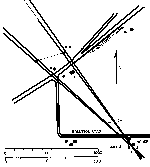
Figure 1: Sighting Locale
Click on Thumbnail to see Full-size image.
[[620]]
If such a good measure could be made for the UFO, we could
distinguish between a distant extraordinary object and a hypothetical
small, close model.
At this point we must be explicit about the geometry of the
situation. We represent the environment as in Fig. 2 . We assume that
the UFO is within a homogeneous scattering layer with T = 1
at 3.5 km. If the UFO were far away and at an altitude greater than
the characteristic dimension of the layer (C in Fig. 2), it would be
large and extraordinary in any case. If it is relatively close,
r = 1 km, the assumptions are justified. Our objective
is to distinguish between cases A and B in Fig. 2 . The sky
brightness, to which all the brightness values are normalized, must
be the sky brightness at the horizon, since this is the value
characteristic of long path length through the scattering layer.
For the solution of the UFO distance, we have two independent
solutions from two independent observations: the illuminated and
shadowed surfaces of the UFO. As was remarked above, it is the
shadowed surface in particular that looks pale and hence suggests
large distance.
Immediately from Table 2 we see that B = 1.21 describes the
part of the UFO, while the illuminated part of the nearby dull
aluminum-painted tank Bo = .885. Since, as the
UFO recedes, B must approach 1.00. We thus know that 1.21 is the
minimum intrinsic brightness of the UFO surface, i.e.
Bo>1.21. Thus the UFO in any interpretation is
known to have a brighter surface than the foreground tank. Thus, the
photometry at once confirms the witnesses' report that the UFO was
shiny, like a fresh, aluminum-painted surface, but not a specular
surface.
The question is, how bright is the surface intrinsically, and what
surface properties would be consistant with both the observed
illuminated and shadowed side? Fig. 3 shows two families of
solutions, one for the illuminated top surface and one for the shaded
bottom side. Solutions for the latter have

Figure 2: Sighting Geometry
Click on Thumbnail to see Full-size image.
[[622]]
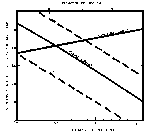
Figure 3: Brightness/Diameter/Distance Plot
Click on Thumbnail to see Full-size image.
[[623]]
an uncertainty introduced by the difficulty of measuring the true
shadow intensity or the tank. The distance is given as a function of
the assumed increase in brightness over the value for the illuminated
or shaded side of the aluminum-painted tank, respectively.
Fig. 3 graphically illustrates the problem. For example, if the
object is a model suspended from the wire only a few meters away, its
surface is some 37% brighter than that of the tank, and the shaded
side is probably more than 40% brighter than the shadow on the tank.
But this is nearly impossible to maintain in the face of the
photometry. Although the distant house's surface is roughly twice as
bright as the tank's surface, its shadows can be only a few percent
brighter, intrinsically, than those on the tank. This is basically
the problem that was suggested by initial inspection of the photos:
the shadowed side of the UFO appears to be so bright that it suggests
significant scattering between it and the observer.
The upshot is that if the top and bottom surfaces of the UFO are made
out of essentially the same material, i.e. with the same albedo, the
photometry indicates that the UFO is distant, at roughly
r = 1.3 ± 0.4 km (est. P. E.). The
witnesses referred to a slightly different hue of the bottom side of
the UFO: they said it was more bronze than the silvery top side. We
have assumed this change in tint had negligible effect on the
photometry, although the implication is that the bottom has slightly
lower albedo. If so the UFO would be still more distant.
There is one last possibility for fabrication which has not been
ruled out. Suppose the object is a small model with a pale grey top
and a bright white bottom (e.g. an aluminum pie pan sealed on the
bottom with white paper). Could this account for the apparent
lightness of the bottom, shaded side of the UFO?
It is difficult to defend this idea in the face of the photometry.
Our analysis of the house indicated that its shaded white surface had
an intrinsic brightness of 0.43, which is very
[[624]]
close to the value measured for the shaded part of the
aluminum-painted tank. Yet hypothetical fabrication requires a
surface on the shaded bottom of the model that is of intrinsic shaded
brightness 0.68, considerably brighter than the shaded part of the
white house. In other words, the photometry appears to indicate that
a
very white surface on the bottom of a small model would be
required to match the appearance of the photographs.
To the extent that the photometric analysis is reliable, (and the
measurements appear to be consistent), the photographs indicate an
object with a bright shiny surface at considerable distance and on
the order of tens of meters in diameter. While it would be
exaggerating to say that we have positively ruled out a fabrication,
it appears significant that the simplest, most direct interpretation
of the photographs confirms precisely what the witnesses said they
saw. Yet, the fact that the object appears beneath the same part of
the overhead wire in both photos can be used as an argument favoring
a suspended model.
Conclusion:
This is one of the few UFO reports in which all factors investigated,
geometric, psychological, and physical appear to be consistent with
the assertion that an extraordinary flying object, silvery, metallic,
disk-shaped, tens of meters in diameter, and evidently artificial,
flew within sight of two witnesses. It cannot be said that the
evidence positively rules out a fabrication, although there are some
physical factors such as the accuracy of certain photometric measures
of the original negatives which argue against a fabrication.
Sources: (Early sources in approx. chronological order).:
- The Telephone Register, McMinnville, Ore., June 8, 1950.
- The Portland Oregonian, Portland, Ore., June 10, 1950.
- The Los Angeles Examiner, Los Angeles, Calif., June 11, 1950.
- Life, June [26], 1950.
- Scheiman, G. E., Project Bluebook Photo Analysis Report 66-22, June 9, 1966.
- Hartmann, W. K., Interview with Mr. and Mrs. Trent. June 6, 1967.
- U.S. Geological Survey Map, Ballston, Oregon 15' quadrangle .
- Correspondence between Colorado Committee and United Press International.
- Middleton, W. E. K., Vision through the Atmosphere (Toronto: Univ.
Toronto Press, 1952).
[[625]]
BACK To Top
